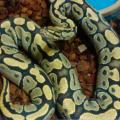» Site Navigation

2 members and 582 guests
Most users ever online was 47,180, 07-16-2025 at 05:30 PM.
» Today's Birthdays

» Stats

Members: 75,912
Threads: 249,118
Posts: 2,572,196
Top Poster: JLC (31,651)
Welcome to our newest member, coda
|
-
Registered User


A Brief History of Ball Python Morphs for Beginners
I decided to find out more about the history of morphs and wanted to share! Feel free to add anything or correct anything that may be inaccurate.
Some good quick reads from this forum if you don’t know anything about morphs yet:
Morphs FAQ - http://ball-pythons.net/forums/showthread.php?t=30766
A Lesson in Basic Genetics - http://ball-pythons.net/forums/showthread.php?t=52847
Quick vocab:
Amelanistic: Albino
Heterozygous: Offspring produced when an animal, such as an albino, is bred to a normal animal carrying dominant traits. All of the offspring appear normal but carry the recessive trait.
A brief history of Ball Python morphs for beginners.
The first Ball Python morph was produced by Bob Clark in May of 1992. In 1989 he had heard from a friend that an amelanistic ball python had been found and captured in Ghana. In May of 1989 he acquired the albino, after some negotiations, and found it to be a 26 inch long male that was “bright lemon yellow and clean white”. The snake was wild caught and therefore came with concerns that any wild caught comes with including that it was not eating. The snake eventually became receptive to captive feeding and although small bred in the fall of that year.
In the spring of 1990 Bob hatched his first clutch of heterozygous snakes and got them up to breeding size in 2 years. They were bred and than in May of 1992 he hatched his very first Albino.
Side detail: In August of 1994 Bob’s facility was broken into and his original male was stolen along with some young albino’s and het females incubating eggs. The thieves were found and punished and you can read the details on Bob Clark’s own web site here: http://www.bobclark.com/news.asp?id=97
It should also be noted that in 1983 Bob obtained an amelanistic Burmese python which he bred and produced heterozygous which produced an albino Burmese python in 1986, the first captive bred python to differ from the appearance of the wild type.
The science in a nutshell: There are a few causes that produce morphs in the wild. The first being environmental causes during incubation such as temperature differences or damage/injury. The second reason being genetic factors when the parent of the offspring passes down the traits of a morph or it spontaneously happens. The spontaneous factor ties in to evolution: if the morph is beneficial to the animal it has a better chance of survival; if it is not the animal will die off with the trait that it carries. This is why the albino’s were so rare in the wild and so sought after and valued amongst collectors. It’s kind of hard to stay camouflaged when you’re bright as day.
During the 90’s morphs became more and more popular. Piebalds and axanthics began to pop up. Piebalds are recorded being found as far back as 1966 however none were captured and brought to the U.S. until the 80’s. In the 90’s breeders began to acquire Piebalds from around the world including Peter Kahl Reptiles who bought and raised a baby Piebald male and acquired a few females from the UK. At this point it was unclear if the Piebald trait was genetically passed to offspring or a random occurence. In 1995 he bred the male to some normal females producing a group of hets. In 1997 the females were old enough to be part of the breeding project and were bred with the male. The result was a clutch in 1998 that hatched a piebald proving that this trait is genetic. I believe that Ralph Davis who purchased some heterozygous offspring from Peter Kahl may have been one of the first producers of the Piebald morph as well.
The Axanthic was first produced and proven a simple recessive in 1997 by Vida Preciosa International, Inc. I couldn't find a lot of info on this one.
From here morphs have exploded and there are easily 60+ morphs out there and it keeps growing. I am not sure if this site is completely up to date with all of the new morphs but I thought it was neat: http://www.stonedevisser.com/morphwi...itle=Main_Page
Some resources and interesting links:
Bob Clark’s Story: http://www.bobclark.com/d_learn.asp?id=39
Peter Kahl’s Story: http://www.pkreptiles.com/informatio...allpythons.asp
Ralph Davis’s Story: http://www.ralphdavisreptiles.com/co...all_python.asp
An article from 1996 Reptiles Magazine by Bob Clark: http://www.bobclark.com/a03_96.asp
-
The Following 14 Users Say Thank You to hermeticcharm For This Useful Post:
- + Show/Hide list of the thanked
-
Angelique (09-10-2009),axeman569 (09-15-2009),Bluebonnet Herp (02-25-2013),Chkadii (11-22-2012),cinderbird (09-11-2009),Coleslaw007 (11-22-2012),eatgoodfood (11-22-2012),Fearless (09-11-2009),Jwkempo (12-11-2014),OhhWatALoser (11-06-2012),PaintShopExotics (08-10-2013),piedplus (11-06-2012),se7en (01-15-2015),Watever (09-10-2009)
-
BPnet Veteran

Re: A Brief History of Ball Python Morphs for Beginners
Thank you for this ! It was interresting
 Originally Posted by hermeticcharm

From here morphs have exploded and there are easily 60+ morphs out there and it keeps growing.
I am just not sure about this. When we talk about "Morph", I think of base morph not combos.
There is a lot of potential combos but the number of base morph is less than 60 (well I think).
I won't list them cause I will surely miss somes 
-
The Following User Says Thank You to Watever For This Useful Post:
hermeticcharm (09-10-2009)
-
BPnet Veteran


Here's a photo of the Pied found in the wild in 1966.

-
The Following 5 Users Say Thank You to Brian Fobian For This Useful Post:
Coleslaw007 (11-22-2012),notmyfault (11-06-2012),Orenshi (11-06-2012),Ridinandreptiles (11-06-2012),snakesRkewl (11-06-2012)
-
Re: A Brief History of Ball Python Morphs for Beginners
 Originally Posted by Watever

Thank you for this ! It was interresting
I am just not sure about this. When we talk about "Morph", I think of base morph not combos.
There is a lot of potential combos but the number of base morph is less than 60 (well I think).
I won't list them cause I will surely miss somes 
here is 100 and I haven't updated in a while
Lesser Platinum
Pastel
Albino
Lori
Caramel Albino
Lavender Albino
Axanthic (VPI)
Piebald
Clown
Desert Ghost
Tri Stripe
Genetic Stripe
Hypo
Blue Ghost
Burgundy
Ultramelanistic
Toffee
Patternless
Black Lace
Black Head
Black Opal
Orange Crush
Peach
Congo
Black Axanthic
Cinnamon
Black Pastel
Enchi
Butter
Mojave
Russo Het Leucistic
Phantom
Mystic
Fire
Sulfur
Yellow Belly
Goblin
Orange Belly
Mocha
Spector
Whirlwind
Granite
Sable
Vanilla
Hidden Gene Woma
Chocolate
Paint
Spotnose
Special
Red Stripe
Disco
Epic
Orange Dream
Black Belly
Calico
Garcia
Gravel
Sentinel
Lace
Green Pastel
Huffman
Josie
Champagne
Coral Glow
Banana
Whitesmoke
Desert
Pinstripe
Spider
Shatter
Marble
Ghi
Woma
Cajun
Candy
Crider
Goldfinger
Tangerine Ultramelanistic
Lemonback
Leopard
Napalm
Puzzle
Reaper
Sugar
Fader
Daddy Gene
Axanthic (TSK)
Axanthic (Jolliff)
Het Red Axanthic
Spark
Autumn Gloss
Rio
Avalanche
Trick
Orange Glow
Mahogany
Diesel
Philistine
Sunset
Static
-
-
Registered User


Re: A Brief History of Ball Python Morphs for Beginners
I have no doubt that there are at least 60 different base morphs out there and that's quite the list you have compiled there but some of the names you have there are redundant. for example butter and lesser. two of the same morphs with different names. just because someone else imports it and gives it his or her own name doesn't mean it's a different morph. the names we give them are just for marketing purposes.
all in all a very impressive list though.
-
-
That was just the first 100 in the database, yes some are repeats, spector whirlwind, goblin yellowbelly and such, but we still have somewhere around 100
The ones that I can't bring myself to add are the 10 different granite types with different names, so many of them and they all look the same to me lol.
-
-
Granites are insane. Like, there are the definite Granite morphs that have all proven out (namely the Co-Dom and Dom variety) but then there seems to be this trend of just calling high patterned normals with some peppering Granites too, has anyone noticed that recently???
I haven't seen an ad on Craigslist for a normal in months, it's always like these people trying to rehome their pet and they think labeling it a Granite will be more enticing. 
Anyway, that was a pretty interesting article. Few things I would probably nitpick but not major.
That picture of the piebald from 60s is neat too, unfortunate it's dead though. 
-
The Following User Says Thank You to MisterKyte For This Useful Post:
-
Re: A Brief History of Ball Python Morphs for Beginners
Old thread and a excited time in History.
Sent from my SGH-T999
-
 Posting Permissions
Posting Permissions
- You may not post new threads
- You may not post replies
- You may not post attachments
- You may not edit your posts
-
Forum Rules
|








 Reply With Quote
Reply With Quote




